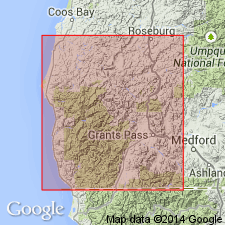
- Usage in publication:
-
- Colebrooke schist
- Modifications:
-
- Original reference
- Dominant lithology:
-
- Schist
- Slate
Summary:
Colebrooke schist. Completely metamorphosed sedimentary rocks, in part mica schists intermingled with slates in which cleavage is highly developed but witbout definite crystalline structure visible to unaided eye. Rocks always fine-grained, with decided schistose structure. Age is pre-Cretaceous; possibly pre-Devonian. [Type locality not stated, but Colebrooke Butte and surrounding country in Port Orford quadrangle are mapped as in this formation.]
[G.M. Butler and G.J. Mitchell (1916) assigned this formation to pre-Jurassic; W.D. Smith and E.L. Packard (1919) assigned it to pre-Cambrian.]
Source: US geologic names lexicon (USGS Bull. 896, p. 486).

- Usage in publication:
-
- Colebrooke schist
- Modifications:
-
- Biostratigraphic dating
- AAPG geologic province:
-
- Western Columbia basin
Summary:
Pg. 2784. In Port Orford area, basal beds of Days Creek formation (new) containing BUCHIA CRASSICOLLIS Keyserling rest generally on Riddle formation, but locally overlap onto Colebrooke schist. Contact with Colebrooke schist is masked by slumping of the schist and is inferred from mapping. Contact of Days Creek with Galice formation and Colebrooke schist is interpreted as angular unconformity.
Source: US geologic names lexicon (USGS Bull. 1200, p. 879).

- Usage in publication:
-
- Colebrooke schist
- Modifications:
-
- Areal extent
- AAPG geologic province:
-
- California Coast Ranges province
Summary:
Pg. 30. Colebrooke schist is considered correlative with South Fork Mountain schist (new). Colebrooke schist occurs in Port Orford quadrangle, Oregon, principally in two areas surrounded by sandstone and shales of Myrtle formation of Diller that ranges from late Late Jurassic to Cretaceous in age. Diller, 1903 (USGS Geol. Atlas, Folio 89) described the Colebrooke as sericite schists, phyllites, and slates that were derived from sedimentary rocks, and he considered it equivalent to schists along South Fork of Trinity River. On geologic map of Oregon, Wells, 1955 (USGS Mineral Inv. Field Studies Map MF-38) discarded name Colebrooke schist and showed those areas of rocks as having been derived from Rogue formation, which consists of lava flows, tuff, agglomerate, flow breccia, mostly of dacitic and andesitic composition, and of Jurassic age. He described rocks formerly named Colebrooke schist as banded crystalline rocks made up of dark hornblende-rich layers and light siliceous layers. Colebrooke schist is overlain unconformably by Myrtle formation of Diller.
Source: US geologic names lexicon (USGS Bull. 1200, p. 879).
For more information, please contact Nancy Stamm, Geologic Names Committee Secretary.
Asterisk (*) indicates published by U.S. Geological Survey authors.
"No current usage" (†) implies that a name has been abandoned or has fallen into disuse. Former usage and, if known, replacement name given in parentheses ( ).
Slash (/) indicates name conflicts with nomenclatural guidelines (CSN, 1933; ACSN, 1961, 1970; NACSN, 1983, 2005, 2021). May be explained within brackets ([ ]).

